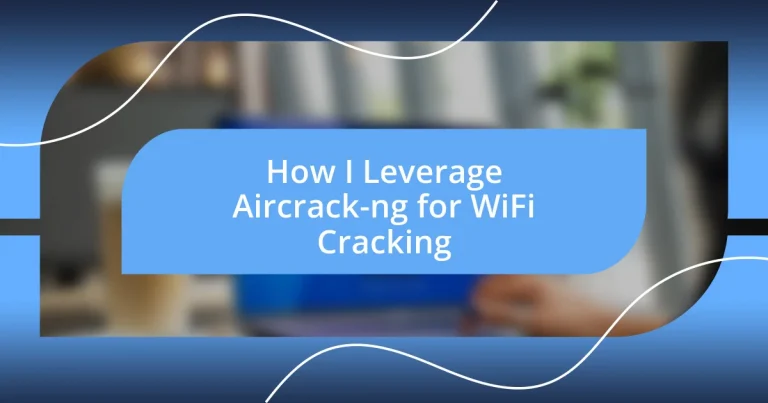Key takeaways:
- WiFi cracking involves capturing data packets and understanding encryption methods (WEP, WPA, WPA2) to analyze network vulnerabilities.
- Setting up Aircrack-ng, especially on a Linux platform like Kali, is crucial for effective WiFi security analysis and cracking processes.
- Ethical hacking requires operating within legal boundaries, maintaining meticulous documentation, and ensuring clear communication to enhance collaborative efforts.
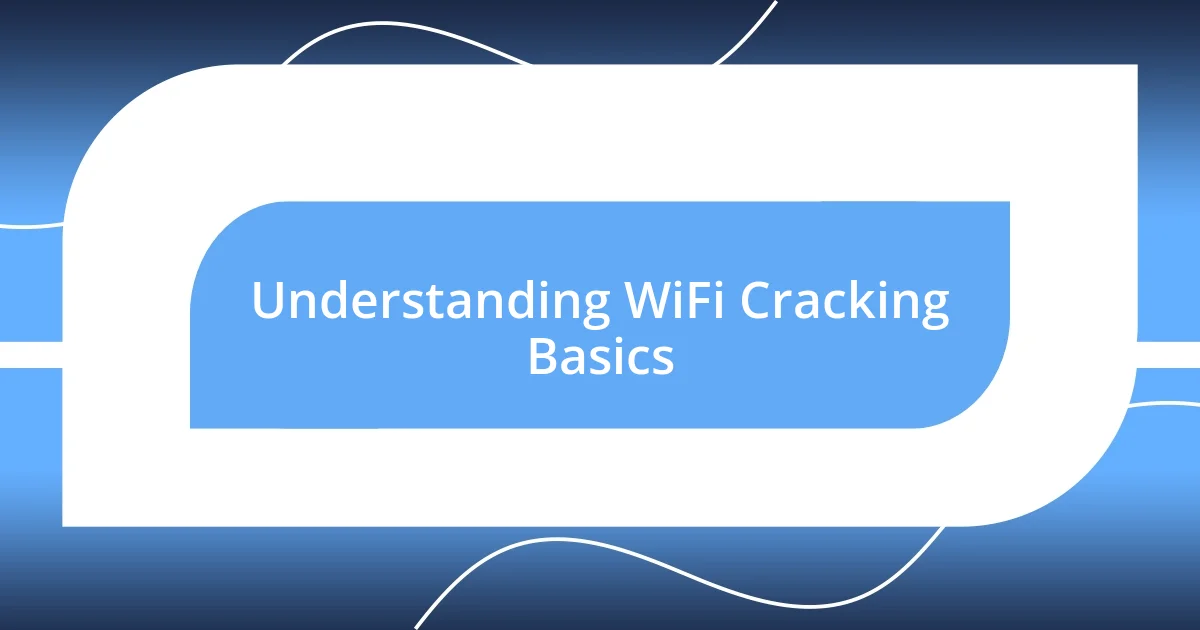
Understanding WiFi Cracking Basics
WiFi cracking might sound like a complex task, but at its core, it’s about understanding how wireless networks communicate. I remember the first time I tried to crack a WiFi network; I was both anxious and excited. Imagining myself as a digital sleuth, I connected the dots between various protocols and encryption methods—essentially, I was trying to unlock a door to see what lay beyond.
The process usually revolves around capturing data packets transmitted over the network. Have you ever considered that every time you connect to WiFi, your device is sending and receiving countless signals? By using tools like Aircrack-ng, I could analyze these packets and try to decipher the passwords hidden within. It’s fascinating how something so technical can be compared to solving a puzzle, where every piece you collect brings you closer to a solution.
Understanding the difference between WEP, WPA, and WPA2 encryption is crucial, as each has its vulnerabilities. When I first learned about this, I was surprised to discover how outdated WEP is—like locking your front door with a flimsy latch. It made me appreciate the importance of secure protocols in our daily activities, fueling my curiosity even more about the world of cybersecurity. What’s your take on the necessity of maintaining strong encryption standards?
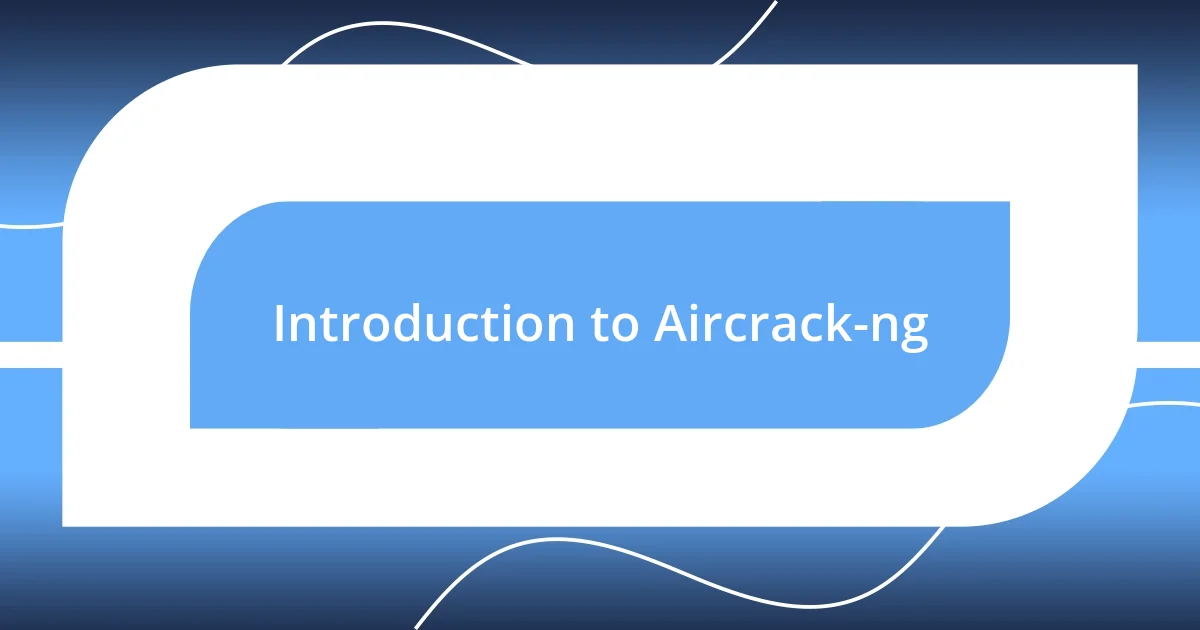
Introduction to Aircrack-ng
Aircrack-ng is an essential suite of tools for anyone looking to delve deeper into WiFi security analysis. I first stumbled upon it during a late-night coding session, captivated by its potential to reveal vulnerabilities in encrypted networks. Realizing it was more than just a tool, I soon recognized that mastering Aircrack-ng meant gaining a more profound understanding of how WiFi operates, which in turn made me feel more empowered in a digital world rife with cybersecurity threats.
Here are some key features of Aircrack-ng that I found particularly enlightening:
- Packet Capture: The ability to capture and analyze data packets is at the heart of Aircrack-ng. It’s like having a magnifying glass to examine every detail of a digital conversation.
- WEP/WPA/WPA2 Cracking: This tool offers methods to crack outdated WEP or more robust WPA and WPA2 encryptions, showcasing the spectrum of vulnerabilities that exist.
- Network Monitoring: Aircrack-ng enables real-time monitoring, allowing you to see what’s happening on your network—a perspective that can be both thrilling and a bit unnerving.
- Implementation Flexibility: Whether in a Linux environment or tailored for various devices, I appreciated how adaptable Aircrack-ng was, fitting neatly into my unique setup.
Diving into Aircrack-ng felt like stepping into a realm where I could raise my cybersecurity awareness significantly. I quickly learned that, beyond just theoretical knowledge, this tool empowered me to actively explore and understand the vulnerabilities in the networks I encountered.
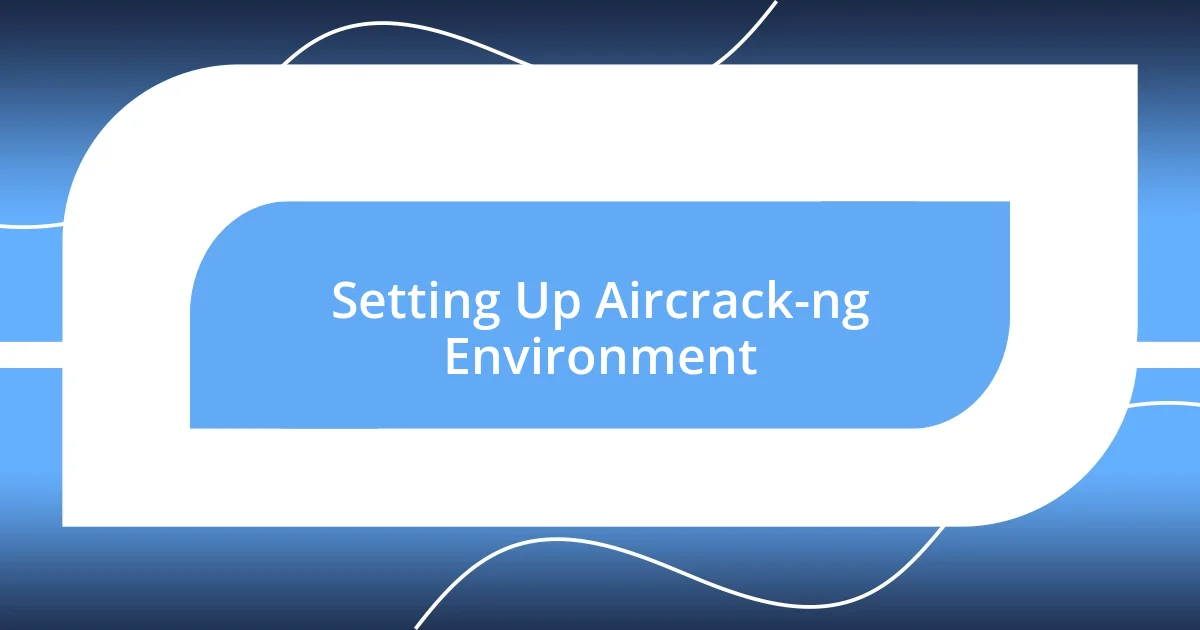
Setting Up Aircrack-ng Environment
Setting up the Aircrack-ng environment is a crucial first step that will set the stage for your WiFi cracking journey. I remember when I first attempted this, it felt a bit overwhelming, almost like preparing for a big exam. You need a compatible operating system; I found that Linux, particularly distributions like Kali Linux, provides the ideal platform. Upon booting up Kali for the first time, there was a sense of excitement—navigating through its security-centric tools, I felt like a detective about to tackle a thrilling case.
Once the OS is in place, it’s essential to install Aircrack-ng, which is straightforward if you follow the right steps. In my experience, this can be easily achieved via the terminal using package managers like APT. Initially, when I typed in the installation command, my heart raced a bit, hoping it’d run smoothly—and it did! A few moments later, I was greeted with the success message, and that rush of accomplishment was exhilarating. It was a clear signal that I was progressing in my quest to understand WiFi security.
To help clarify the setup process further, here’s a comparison of different operating environments you can use with Aircrack-ng:
| Operating System | Ease of Setup |
|---|---|
| Kali Linux | Very Easy; pre-installed |
| Ubuntu | Moderate; requires additional dependencies |
| Windows | Challenging; requires WSL or other workarounds |
By providing these insights, I hope to ease some of your initial concerns and prepare you for the exciting challenges ahead in mastering the art of WiFi cracking with Aircrack-ng. Each setup step contributes to a stronger foundation, ultimately leading to a more rewarding experience.
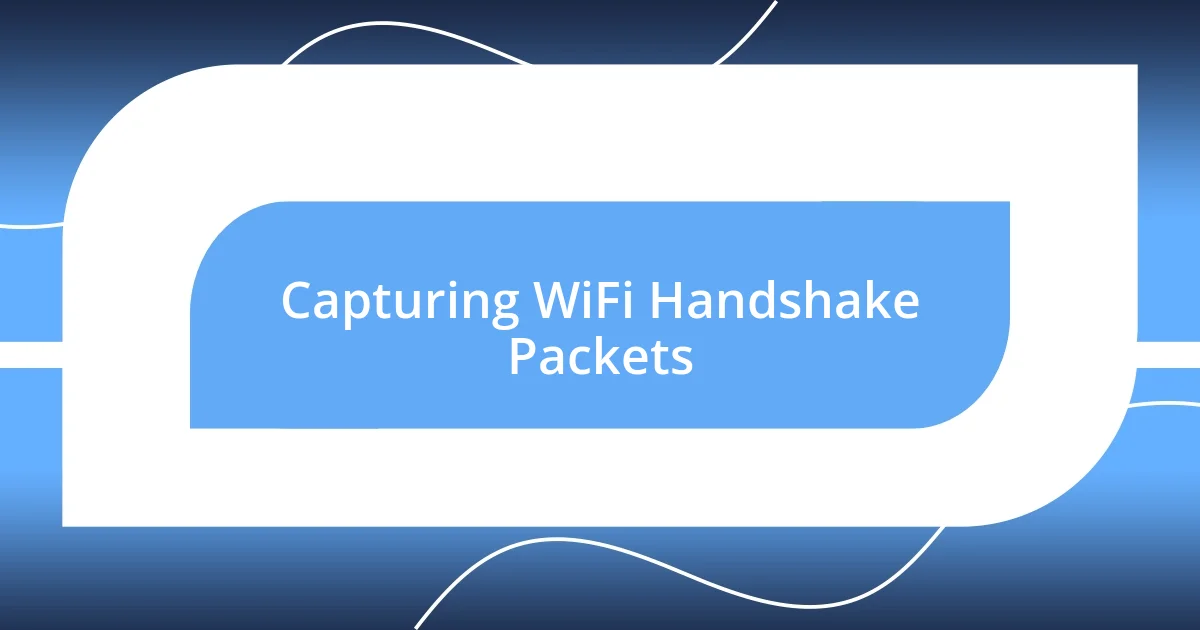
Capturing WiFi Handshake Packets
Capturing the WiFi handshake packets is a pivotal moment in your WiFi cracking journey. It’s akin to waiting for the perfect shot while hunting; those fleeting seconds are filled with anticipation. When I first set out to capture handshakes, I was eager but also anxious, realizing that timing and technique mattered. Using airodump-ng, I navigated through available networks, my heart racing as I aimed to capture that elusive handshake. The thrill of seeing the packets bubbling up was a reminder of how each packet carries essential information that would eventually lead to cracking the password.
To successfully capture these handshake packets, you’ll need to make sure that your wireless card is set to monitor mode. I distinctly remember the moment my command for enabling monitor mode entered my terminal; it felt like flipping a switch to a world filled with possibilities. After activating monitor mode, I felt a rush of excitement every time a device connected to the network, hoping it would result in a handshake. I still find it fascinating how such a simple exchange, a fleeting moment when a device connects, can unlock a treasure trove of knowledge about the network’s security.
As you embark on this process, consider how you can increase your chances of capturing a handshake. One technique that I found useful was conducting de-authentication attacks on the connected devices—this essentially tricks them into reconnecting, prompting that handshake to occur. While it may sound technical, I assure you, the feeling of orchestrating this interaction is incredibly satisfying. Have you ever felt the exhilarating rush of capturing something so ephemeral yet so vital? The first successful capture left me with an overwhelming sense of achievement, laying the groundwork for what would soon become a deep dive into WiFi security vulnerabilities.
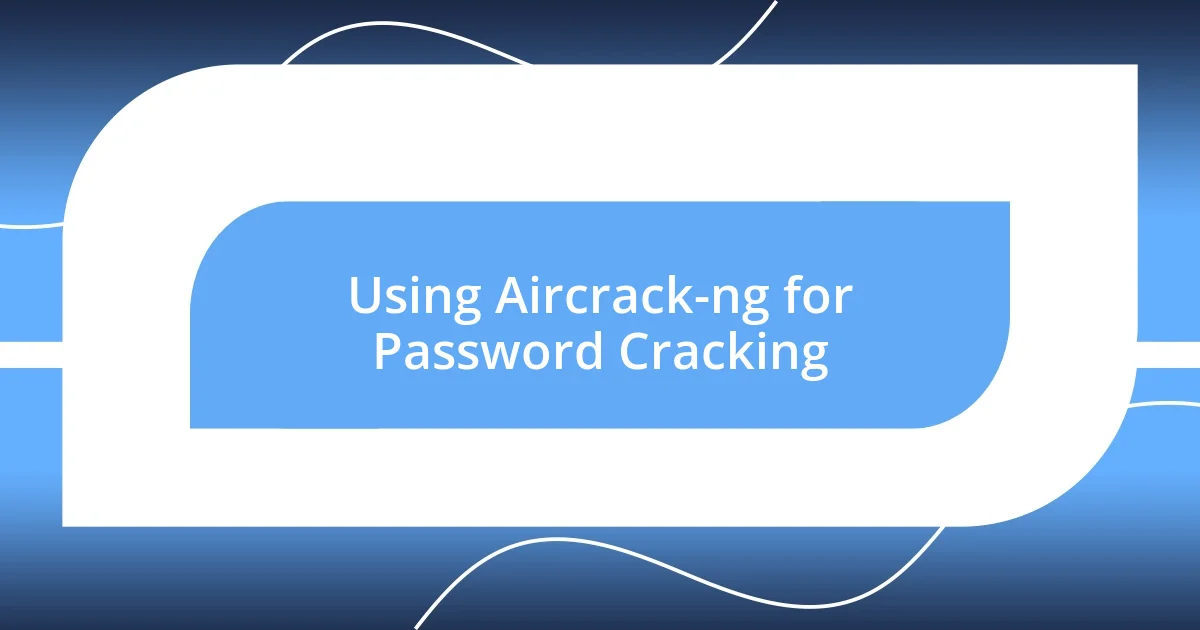
Using Aircrack-ng for Password Cracking
Using Aircrack-ng for password cracking is where the fun really begins. Once you have your handshake packets captured, it’s time to put Aircrack-ng to work. I vividly remember my first attempt at cracking a WPA/WPA2 password; my heart raced as I watched the terminal processes. It felt like a game of mental chess—each line of code entered was a calculated move toward claiming victory. The anticipation was palpable as the tool worked through my wordlists.
What I find particularly fascinating about Aircrack-ng is how it allows for different options in cracking methods, such as dictionary attacks, which are incredibly effective if you have a well-curated wordlist. I recall spending hours building my wordlists, incorporating everything from common phrases to my favorite songs. The thrill of cracking a password through sheer effort was unlike anything else! Have you ever felt the satisfaction of seeing a password unfold before your eyes after a solid strategy? It’s a reward that not many other tasks can provide.
If your initial attempts don’t bear fruit, don’t feel discouraged. I experienced my fair share of failures, especially when I thought I had a strong wordlist but ended up facing complex passwords. It took some trial and error, but I learned the importance of refining my lists and exploring other options, such as brute-force attacks for particularly stubborn passwords. Each setback only fueled my determination and deepened my understanding of the WiFi security landscape, making the eventual successes even sweeter!
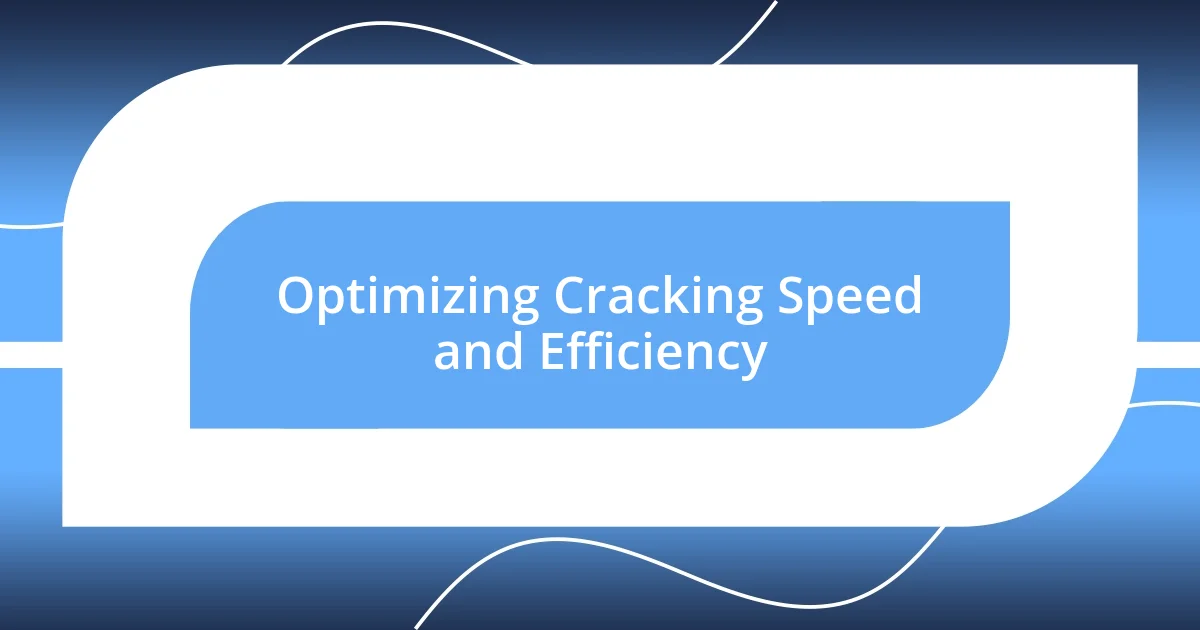
Optimizing Cracking Speed and Efficiency
When it comes to optimizing cracking speed and efficiency with Aircrack-ng, I can’t stress enough the importance of choosing the right hardware. I remember upgrading my wireless adapter to one that supported packet injection; the difference was night and day. Suddenly, my cracking sessions felt less like a waiting game and more like an adrenaline-pumping race against time. It’s like swapping a bicycle for a sports car—suddenly, you’re not just moving faster; you’re zooming ahead of the competition!
Another practical tip is to fine-tune your wordlists for maximum effectiveness. The first time I tried to crack a particularly tricky password, I realized my wordlist was bloated with unused words. I went back to the drawing board and trimmed it down to the essentials. I focused on relevance and specificity: I looked at my network’s potential user demographics and their likely passwords. Have you ever thought about how your personal experiences can shape your password choices? That thought process allowed me to craft more impactful wordlists, which significantly sped up my cracking attempts.
Lastly, utilizing a distributed approach can dramatically enhance efficiency. I have fond memories of connecting with fellow enthusiasts, pooling our resources to crack a password collaboratively. The thrill of sharing tips and strategies—like a secret club dedicated to unraveling security—made the process a lot more enjoyable. It’s fascinating how teamwork can drastically reduce the time it takes to crack a challenging password. So, have you considered joining forces with others who share your passion? You might discover that the collective knowledge and effort can lead to breakthroughs you never imagined possible.
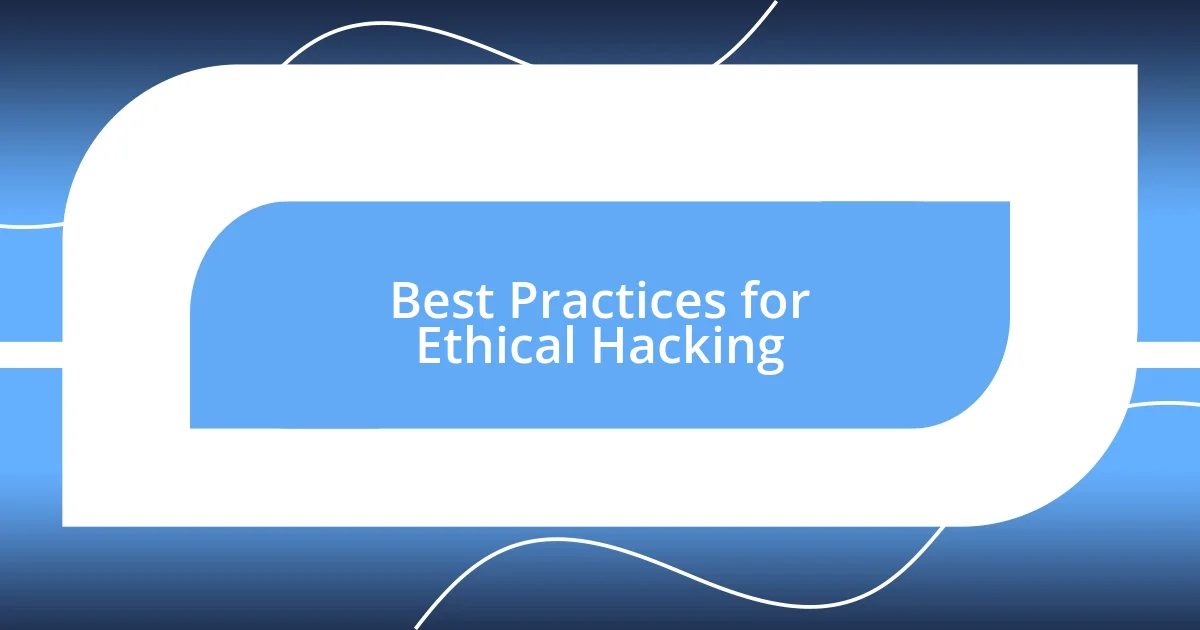
Best Practices for Ethical Hacking
When diving into the world of ethical hacking, one of the best practices I emphasize is to always operate within legal boundaries. I remember hearing stories of hackers who went too far and ended up facing serious legal consequences. The thrill of cracking a password can easily cloud judgment, but it’s crucial to remember: ethical hackers are those who explore vulnerabilities with permission. Have you ever thought about the implications of your actions? It’s a responsibility that comes with the territory.
Equally important is maintaining clear documentation of your actions and findings. During one project, I took meticulous notes on every attempt and result. This not only helped me analyze what worked and what didn’t, but it also allowed me to provide valuable insights to clients later. Documentation is like creating a roadmap of your journey through the WiFi landscape. Without it, you might lose sight of your progression. Could you imagine retracing your steps without any clues?
Finally, effective communication with your clients and teammates is paramount. I recall a collaboration where poor communication led to overlapping efforts—what a waste of time that was! It taught me that being open and transparent about strategies and findings makes the whole process smoother. Have you ever felt the tension that arises from misunderstanding? Keeping everyone on the same page not only builds trust but also enhances the collective problem-solving effort, making it a truly rewarding experience for everyone involved.












